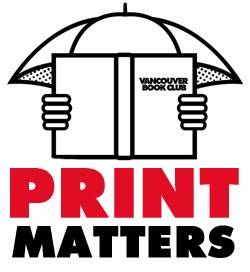 |
Print Matters is a celebration of the printed form and all the awesome local people who bring it to you: literary journals, publishers, magazines, hand presses, and independent booksellers. |
| This week we look at Heavenly Monkey, a letter press imprint started in 2000 by Rollin Milroy. Operating out of his backyard studio in East Van, Milroy has produced 2 dozen titles "for people interested in contemporary applications of traditional book crafts." |
When meeting Rollin Milroy for the first time it's difficult not to bring up the question of how his imprint, Heavenly Monkey, got its name. An Internet search doesn't bring one closer to the answer, other than to make a suggestion on where you might find it.*
As Milroy says, the answer is not nearly as interesting as the question.
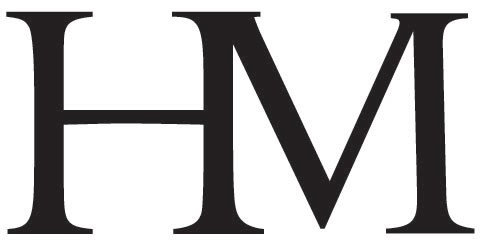 |
"When people ask the question they have all kinds of scenarios in their mind and it's much more fun for them, I think, to leave them with their scenarios than to give them the answer because it's really not that interesting, really. It's something that came to me. It struck the kind of tone I wanted to strike, which was there are an awful lot of people who get into this, who are very, very serious, and name themselves something very, very serious. And I think it's good to take what you do seriously but I'm not a big fan of people who take themselves too seriously. So I wanted something that would really stand out in a booksellers catalogue, that didn't fall into the same trope." |
The name also captures the spirit of the books that he publishes.
"They are, they can be, playful. They certainly are not attempting to follow the traditional path a lot of fine press, which is a phrase I hate. A lot of fine press is very backward looking."
Looking at its back catalogue one can see that Heavenly Monkey is anything but backward looking. While many fine presses choose older, more popular, texts as their source material, knowing that what they produce has a dedicated audience, HM's inspiration comes from a diverse selection of writers, artists, and even other bookmakers. A 15th century type designer, H.P Lovecraft, and Barbara Hodgson, among others, can all be found within the pages of a Heavenly Monkey project. Right from the start, Milroy had no intention of doing what was expected of a fine press.
"I don't really see the value to that. One reason (other presses) do it is that the material is free; they don't have to deal with anyone living regarding copyright and all that kind of stuff. Another reason is that a lot of people who buy these things don't really have a very highly developed sense of their own personal taste. They buy what is safe. You can buy any of the classics and know that it is a classic piece of literature, how much could they have messed it up? But to look at something where maybe you don't know the author, you don't know the text, you don't know much about anything and to have to rely entirely on your own taste as a collector, there aren't a lot of people out there with the courage to do that.
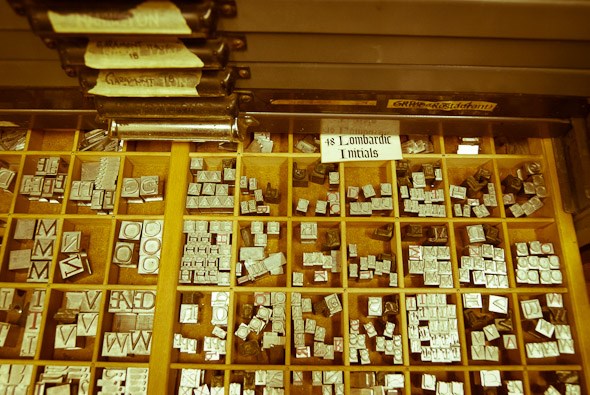 "A lot of people who do what I do aren't book collectors. They love printing. They love playing with type. But they don't spend a lot of their own money on books. They're not collectors. They don't spend hundreds of hours in bookstores. They don't know a lot of booksellers. They don't know that side of the business."
"A lot of people who do what I do aren't book collectors. They love printing. They love playing with type. But they don't spend a lot of their own money on books. They're not collectors. They don't spend hundreds of hours in bookstores. They don't know a lot of booksellers. They don't know that side of the business."
It was as a collector that Milroy found himself drawn into the world of letterpress books. With a background in journalism, magazine publishing and then marketing, Milroy says that it was "just sort of a logical progression" that brought him to starting his own press.
"I was a comic book collector and then I got into collecting modern firsts, which are signed books. It's not very interesting or creative collecting, but that's how I got into. And from there I discovered a press that was doing basically what I do now. So that was interesting to me. I had never heard of letterpress.
"I was always hanging around the graphic department at the publishing companies. I was very interested in the process of printing and printmaking. I was young, had no kids, a lot of disposable income to spend on books. Then I got a job in which I travelled a lot. I'd be away for weeks and months and when you're in a strange city on a weekend with nothing to do, and you don't know anyone, you go to the bookstores. So I got to go to a lot of good bookstores in America. And that really helped educate me about all kinds of things around collecting and book making. And I was becoming more and more interested in this kind of book, fine press. So I wanted to educate myself as a collector. I wanted to know what is good printing, what is good binding, what are the technical issues you should be looking for.
"So that's how I got into it and it kind of dragged on for a period of two or three years. And I got more and more interested and it was fun."
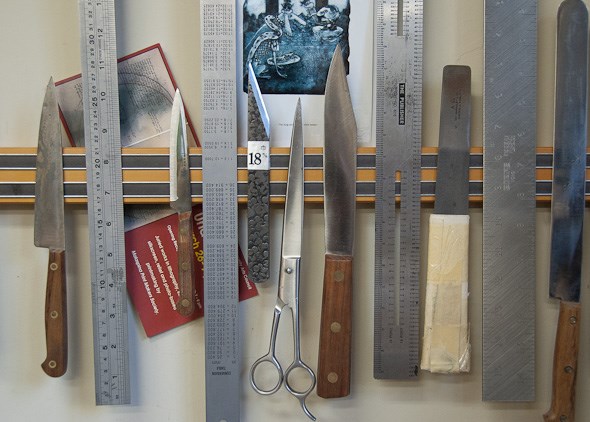 In the end it was a decision about whether or not to relocate to Southern California for work that was the impetus to seriously pursue his new passion. The cons for moving far outweighed the pros.
In the end it was a decision about whether or not to relocate to Southern California for work that was the impetus to seriously pursue his new passion. The cons for moving far outweighed the pros.
"So we just decided that I wouldn't do that any more and (my wife) was totally supportive of that. And so I decided I was going to do this and see how it goes. It worked out really well, our daughter came along shortly thereafter, so I'm totally free to do all the stuff you need to do when you've got a kid under 12 or whatever, running around and getting them to school. So I can fit that in so it wasn't a worry or a cost. My wife continues doing work that she loves to do. It's just worked out really well.
"I could be making a lot more money but I wouldn't be as happy a person. I'd probably be a lousy parent, a lousy husband. So it was the right decision for us."
Unlike many fine presses, Heavenly Monkey does not rely on a subscriber base to ensure a certain amount of sales. Right from the beginning Milroy knew that would not work with the types of books he wanted to produce, partially due to the eclectic nature of the work and the frequency of output.
"A lot of presses have devoted collectors (who) buy everything the press puts out. Very few people can do that with my books. They can't afford them at the rate they come out, and some of (the books) are increasingly getting quite expensive. And more importantly, not every one of my books is going to appeal to every person and the last thing I want is for someone to subscribe and then say 'Oh, I've got to buy this book and it's $1000 and doesn't really interest me that much but I've got to because I want to make sure I get the next one.' So I never went that route."
Instead, Milroy chose to sell only to booksellers, By doing so, not only does he not have to worry about satisfying the particular needs of a client base, he also doesn't have to spend a lot of time on promotion and marketing.
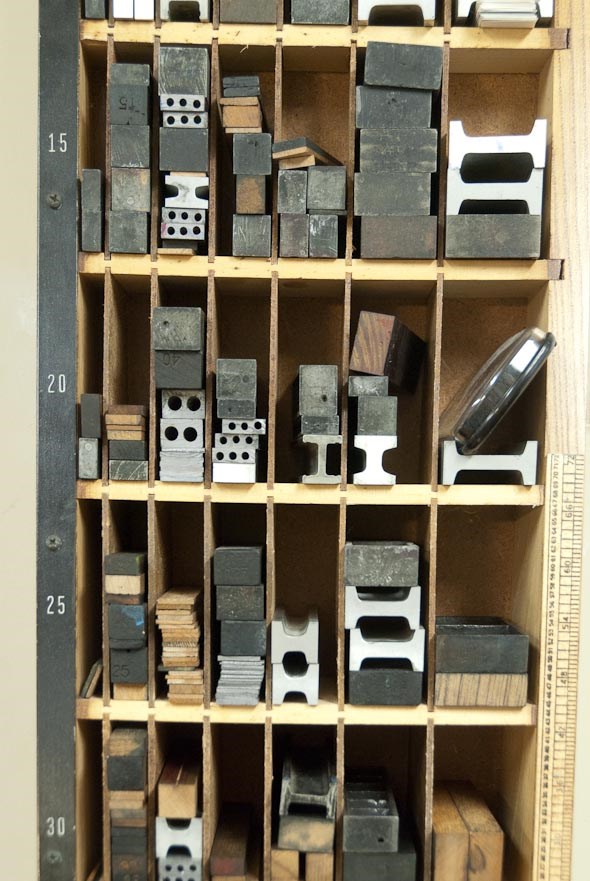 "Booksellers have a much higher tolerance for the variation (of my books). As long as they think the book is worth the price I'm putting on it, and they therefore think they can find a buyer for it, I don't have that same restriction of it having to fit into their collecting interest. Also they will sell books much better than I ever will. They know many more people than I ever will. Selling books takes a lot of time. I'm not interested in client development. I'm not interested in schmoozing with collectors. There are some people who genuinely are very good at that, and like it. I don't. I want to be left alone to do my thing.
"Booksellers have a much higher tolerance for the variation (of my books). As long as they think the book is worth the price I'm putting on it, and they therefore think they can find a buyer for it, I don't have that same restriction of it having to fit into their collecting interest. Also they will sell books much better than I ever will. They know many more people than I ever will. Selling books takes a lot of time. I'm not interested in client development. I'm not interested in schmoozing with collectors. There are some people who genuinely are very good at that, and like it. I don't. I want to be left alone to do my thing.
"I love booksellers. I love that there are bookstores in the world and I like working with them very much. There's nothing better than being picked up by a booksellers whose stuff you've always admired, you've always thought 'Gee it would be cool to get into one of their catalogues,' and to get in. It's like being picked up by a dealer, if you're an artist."
Milroy works mostly with US booksellers, plus a couple on the U.K. The Vancouver book landscape, unfortunately, doesn't support stores that might carry Heavenly Monkey books.
"There are a couple of booksellers in Vancouver who have always been supportive of me, right from day one, and I appreciate that. Don Stewart at MacLeods and Lance McCaughran at Criterion, but they don't really have customers (for my books). My experience is that Canadians don't buy the kinds of books that I make. My books go to the States, they always have.
"A lot of my books end up in special collections at universities. That's great, but I hope that not too many of my books go into libraries, though, because once they go into libraries they're lost forever. I like the idea that collectors will buy them and have them for a period of time and then they'll come back on the market and hopefully another collector will have the opportunity to have them for a while."
In 2005, Milroy created a new imprint, Heavenly Monkey Editions, for books that are the result of collaborations with other artists and writers, with Milroy acting as a project facilitator and publisher.
"What I found was that I was encountering people who had really cool book ideas but they did not have all of the skills necessary to make and publish such a book. I saw the opportunity to say, 'Look. I can help you. I can fill in your gaps and we can make that book.' And it was instances where the book would appeal to me, something I would want to own.
"So I felt because these were not books entirely of my creation or my initiation, I should differentiate them. They're not printed on the hand press. They're not all made the way Heavenly Monkey books are made. Some of them are. Some of them might partially be. Some of them are completely not. So I thought it was important to make that distinction because Heavenly Monkey has come to be about books that are made in a very specific way."
And that specific way is something that Milroy has developed over time, through trial and error, experimentation with materials, and by developing relationships with local artisans. To begin with, Heavenly Monkey books are printed on a one-ton Washington hand press, an impressive piece of machinery.
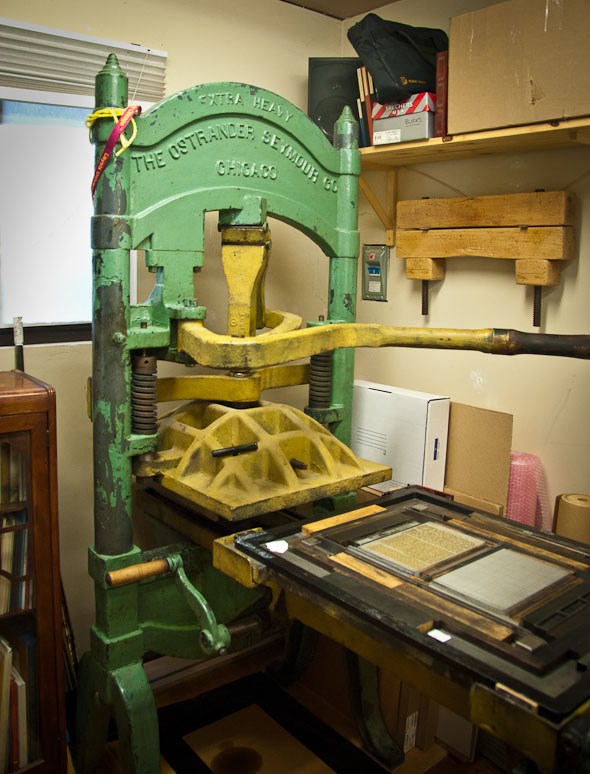
"Although there are a lot of people making letterpress books, there are very very few, and I can't think of five, who are making books in exactly the same way as I do, which is printing on a hand press. A lot of people print by hand, but that's not the same as printing on a hand press. And it's a distinction that probably doesn't matter nearly as much to anyone else as it does to me but it's important because you can print on a hand press the way you cannot print on any other kind of letterpress. You can achieve results that you simply cannot technically do on any of the other presses. I'm very much going after an aesthetic that is defined by what a hand press can do and the materials that are best suited to a hand press."
That Heavenly Monkey aesthetic is further defined by Milroy's choice of paper and the way he prints on it. Using paper made especially for him by local paper maker Reg Lissel, Milroy prints on dampened paper. His decision to start printing this way came about as a solution to a problem.
"I was having a lot of problems getting good printing, and dampening, I'd read, makes it easier. So I thought, 'Oh, I'll dampen it. So much easier.' (chuckles) Well, it doesn't actually work that way but certainly once you do start printing damp you can't go back. There's just nothing close and it's so much richer and sharper. You use a lot less ink to get a much darker black. So you get much sharper letter forms.
"When you're printing damp the paper is not wet, it's just damp. So when you feel a sheet of damp paper it doesn't feel wet. It feels cool, and it's just completely limp like a piece of overcooked spaghetti. It's just completely relaxed. You use a lot less ink because you don't have to use all that extra ink in an impression to get through the hard paper. It's been softened and relaxed. You have to get the balance just right but the ink takes beautifully. More importantly is that a sheet expands when its damp, so when you print on it and then you dry it, it contracts so the letter forms shrink about 2 or 3% so it gets even sharper.
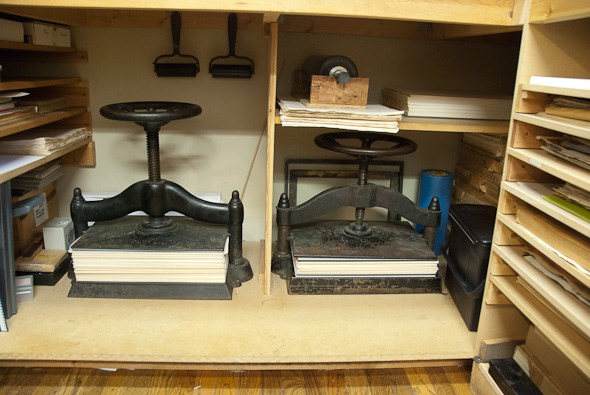
"Reg makes the most incredible paper. He's been working with me for about 10 years now. He's entirely self-taught and he's a really interesting guy. There are a lot of people who make what I call "hippie paper," stuff with a lot of weird crap in it. Anyone can do that. What's really hard is to make a thousand sheets of white paper that are consistent. And to make it good. And he can do that.
"Over a number of years we've worked together on perfecting the kind of paper I need to dampen and print on. So this is the most perfect paper for printing on a hand press. It's heavily, heavily sized which means there's a lot of…it's almost water resistant.
"One of my most favourite sheets that he makes is an overbeaten abaca. It's almost like vellum, like real animal vellum, and it's tough as hell. So I use that for certain kinds of bindings. And it makes this really beautiful, limp, vellum kind of binding. I love the feel of a limp binding. Stiff bindings are not friendly. And how books feel in your hand is really important to me."
A lot of the projects Milroy produces are collaborations with writers, artists, and other book artisans. He is usually the one to initiate the conversation that will lead to a completed book. He doesn't take submissions or manuscripts, but rather follows up when he encounters someone whose work appeals to him.
"Most often it's someone who isn't already working in books. Someone whose work I think could be brought into my world. And also when I talk to them, finding out they're someone who appreciates books, who loves books for being books, and is interested in it. I would never want to work with someone I had to talk into a project.
"Right from the beginning there tends to be an acceptance from all parties that 'Okay, you're the person that knows this area of what we're going to do and I'm the person that knows this area. I'm going to tell you what I'm going to do.' And we can talk and give each other feedback but basically the project gets parceled up and then my job, as the publisher, is to coordinate to make sure all the parts are going to come together in the right way at the right time."
"I don't believe in art directing (people). If I'm going to invite them to come in and play, there's no fun for them if I start telling them I want the pictures to be kind of like this or like that. I can lay out some general parameters, the size, the budget, the technical issues. But other than that I think you should stay out of people's way and let them be creative because that's when you'll get the best work. Be there when they need something but otherwise stay out of the way and you'll always be amazed by what you get. Now, it might not be what you or I would have done. It might not even appeal to me as much as some other things but that isn't what's important What's important is that it's what they thought was right for the project. That's why I think it has worked so far."
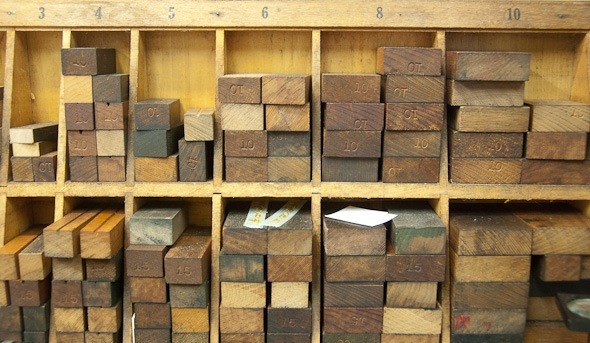 Milroy is currently working on a project with Seattle artist David George, who creates amazingly beautiful photograms. Milroy was introduced to George's work through a mutual friend and he thought the work was "stunning."
Milroy is currently working on a project with Seattle artist David George, who creates amazingly beautiful photograms. Milroy was introduced to George's work through a mutual friend and he thought the work was "stunning."
"I went to the talk that Brian Eno gave last year...and he talked about painting with light. And that's how I describe David's photograms to people. He's creating these original things. They're not photographs. There's no matrix. You can't reproduce them. And he's basically using light as if he had a paint brush.
"So I pitched David. I said, 'This is cool. I've never heard of photograms, maybe this is something we could do.' His issue has always been that he's got these originals but they probably start at $300 for the smaller ones. He's wondered about opportunities to make editions or duplicates, and he's played with doing enlargements with Giclee, inkjet, but that's not very fun. If you're a darkroom person you want to do things on real paper.
"So the obvious answer was photo etching, which is a photographic process but you're making an intaglio print. And one of my ongoing collaborators is Peter Braune on Granville Island at New Leaf Editions, so whenever I want to do anything intaglio I go and talk to Peter. And Peter's answer to anything is 'Yeah. I can do that.' So we got some very high-res scans of the images from David, we made some test plates and I've got the proofs out in my studio now. I'm going to be sending them to David. I have not seen the originals of these, I've only seen the scans but it's still not the same. So I'm not sure what the fidelity will be like. I'm sure it's pretty good.
"David understood from the beginning that whatever we do it is not going to be a reproduction. We're taking one medium and transferring it to another medium, so the image is going to be affected. Now the question is, is it going to be affected in an artistic and interesting way? Is it going to be something that is not only cool but also separate from the original? Or is it just a reproduction?"
When the average person looks at the price of a Heavenly Monkey book, there are bound to be a few head shakes. These are not your mass-marketed trade publications that might eventually find their way to the Chapter's bargain table. And yet, it's not as if Milroy and the artists he works with are raking in the dough.
"Some people look at the things that I do, the books that I publish and they see the price, and they think, 'My god, there's a goldmine to be had here.' Especially artists. So they think 'I'm going to do an expensive book.' And they do an expensive book. And it doesn't sell. And they don't know why it doesn't sell. And it doesn't sell for a number of reasons but the most important one was that they thought they were going to get rich doing this, and you don't. The price you see is not the price you realize. Just because you set a price like that doesn't mean you're going to sell however many copies you've made.
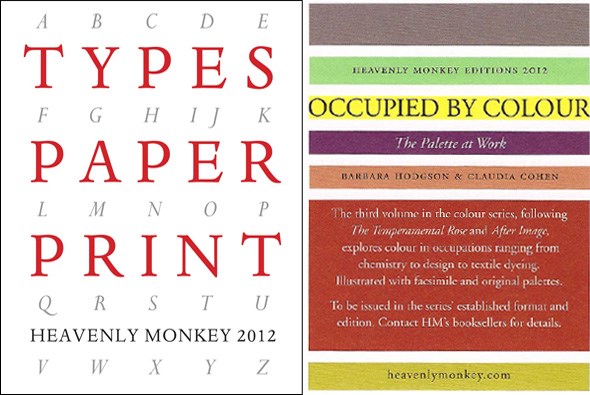 "Some people focus on the price of these things and the cost and wonder 'How can books cost that much?' Well, if you don't understand the process, the price makes no sense to you. But if you do understand the process, and therefore are interested in the process, the price makes sense to you. Now, whether you're prepared to pay that price for that book is totally up to you and your taste, which is the rest of the fun.
"Some people focus on the price of these things and the cost and wonder 'How can books cost that much?' Well, if you don't understand the process, the price makes no sense to you. But if you do understand the process, and therefore are interested in the process, the price makes sense to you. Now, whether you're prepared to pay that price for that book is totally up to you and your taste, which is the rest of the fun.
"What I tell people when we're starting a project is, however we work the finances of this out, we've got to sort of arrange it so we all come out equally poor. None of us is going to do well but if we sort of spread the pain around and we are all happy that at the end of the day we're going to get a couple of copies of a really cool book, and enough money to cover the capital costs, and maybe earn a dollar an hour for your labor. You've got to work with people who are willing to work way below the minimum wage. I work with people who get that side of it."
Milroy admits that he has a low boredom threshold, which is one of the reasons for having such an eclectic catalogue. It also explains why his editions sizes are small, usually no greater than 50 copies.
"Once you've figured something out, once you've solved the problems of a given day then it's just production. And production gets boring."
So how does he keep it enjoyable? Even though he has to frequently navigate through the collaboration process, in the end it's all about being answerable to no one but himself and creating something that brings him pleasure.
"I like what I do because every day I wake up and pretty much I decide what I want to do. There's lots of stuff I can do, I've always got lots of projects going on, I get to pick the one I want to do today.
"Unlike a lot of people, I do nothing for anyone else. You cannot hire me. I'm not for hire. Anything I do is for me. So I don't have any clients. I don't have to worry that I've got to get this done because so-and-so wants it or is this good enough for so-and-so. I'm the only person that matters. I'm the only person I have to think about. And at the end of the day if I make a pile of books that no one wants, well, unfortunate for me but if I'm happy with the book, that's the most important thing.
*To aid in your search for the secret behind its name, Heavenly Monkey suggests on its website tracking down a copy of the HM 2002 Christmas Book. You can find copies of it, along with a collection of everything that Heavenly Monkey has produced thus far, in the Rare Books & Special Collections library at UBC.


